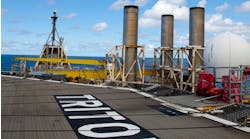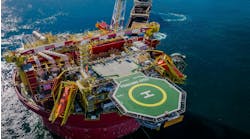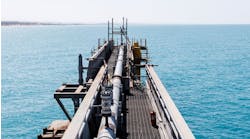UK offshore decommissioning on the rise following slowdown in 2020
Offshore staff
LONDON – The pace of decommissioning is picking up across the UK North Sea following a slowdown last year, according to industry association Oil and Gas UK (OGUK).
The Decommissioning Insight 2021 report predicts that 150 wells will be P&A’d in UK waters this year, compared to 84 in 2020 when activity was constrained by COVID.
Over the next few years, annual UK decommissioning expenditure should top £1.5 billion ($2 billion), with close to 600 wells and around 45 topsides and jackets to be removed, along with 69 km (43 mi) of pipelines, 6,000 metric tons (6,613 tons) of subsea structures and just over 4,000 mattresses.
Despite last year’s problems the UK industry still spent almost £1.1 billion ($1.47 billion) on decommissioning, only 20% less than in 2019. This year, the report forecasts a total spend of £1.45 billion ($1.93 billion), and £16.57 billion ($22.11 billion) over the next decade.
By 2030, the industry should have spent just over £26.5 billion ($35.36 billion) on decommissioning.
The industry currently accounts for 12.1% of UK offshore expenditure.
Over half of the decade’s predicted spending will go on decommissioning 1,782 UK offshore wells including 152 additional wells not covered by previous analysis.
Close to 43% of the decommissioning expenditure to come will be on projects in the central North Sea (CNS), with almost £4 billion ($5.34 billion) allocated to wells. Expenditure in the southern North Sea (SNS) accounts for almost 30% this year, but the proportion is set to decline from the middle of the decade, as some large projects come to an end.
Then the focus looks set to shift to the East Irish Sea and west of Shetland.
Post cessation of production (CoP) running costs are higher in the northern North Sea (NNS) and CNS because the facilities there are much larger and more complex. However, in the SNS tail-end decommissioning activities such as site remediation play a larger role.
Over the next decade, 117 suspended exploration and appraisal wells are also likely to be decommissioned, almost 50% more than in last year’s forecast, at a cost of £509 million ($679 million). This is due to new guidance from the Oil and Gas Authority on timelines which recommends that operators put together plans for decommissioning these wells within two to five years, where possible.
The report notes an increased willingness in the industry to collaborate on multi-operator, multi-well decommissioning campaigns, and success with suspended E&A wells could influence other areas of well decommissioning.
By the end of the decade a further 125 UK offshore topsides (704,230 metric tons/776,281 tons) and 115 jacket structures (382,308 metric tons/421,422 tons) should be decommissioned. Topsides removals between 2021 and 2025 will average around 50,000 metric tons/yr (55,116 tons), and substructure decommissioning around 20,000 metric tons (22,046 tons).
Although 15 topsides are set to be removed in 2023, all are smaller structures in the SNS.
Subsea decommissioning accounts for 9% of the overall expenditure forecast, with £1.531 billion ($2.04 billion) due to be spent over the next 10 years. During this period, almost 350 km (217 mi) of pipelines, 90,000 metric tons (99,208 tons) of subsea infrastructure, and 17,000 mattresses should be removed.
There could be a spike in removals activity in 2030 as a few larger subsea structures are then forecast to be decommissioned in the CNS.
The report also found that the UK sector currently does the most North Sea decommissioning work. Over the next decade across the North Sea as a whole, more than 200 wells look set to be decommissioned annually, and 2,679 wells in total.
These comprise 528 wells offshore the Netherlands, 278 in Norway and 91 in Denmark.
As for topsides decommissioning throughout the region, just over 1 MM metric tons (1.1 MM tons) will be removed over the next decade, peaking at almost 160,000 metric tons (176,370 tons) in 2029 before dropping back to just over 120,000 metric tons (132,277 tons) in 2030.
Dutch scopes should start rising from 2023, with a few large Norwegian scopes predicted for the end of the decade.
Joe Leask, OGUK’s Decommissioning Manager, said: “Over the last five years the UK decommissioning industry has improved its efficiency and cut its costs by an estimated 23%. So, we have done better but I think we can still do a lot more.
“If operators work together to create larger projects where we get economies of scale, then we can safely drive costs down even more.”
Performance is improving. Ten years ago, Leask said, it took around 100 days of offshore activity to remove the topsides from the North West Hutton platform. This summer, two facilities the same size were removed during a similar time frame.
“Decommissioning is also a key part of the UK’s transition to low-carbon energy and its aim of reaching net zero by 2050. This is partly because the installations being removed tend to be older and so generate more emissions relative to the oil and gas they produce.
“But it is also because of the growing opportunities for reuse, repurposing, and recycling. Reuse is when infrastructure or equipment is taken away and used again elsewhere. This is already becoming common with forgings, pipeline valves, turbines, and electrical kit.
“In the future some assets could be repurposed for new uses such as offshore wind and permanent storage of carbon dioxide by pumping it deep under the seabed.”
However, even in their new roles, these facilities will still need to be decommissioned, he pointed out.
11/29/2021



